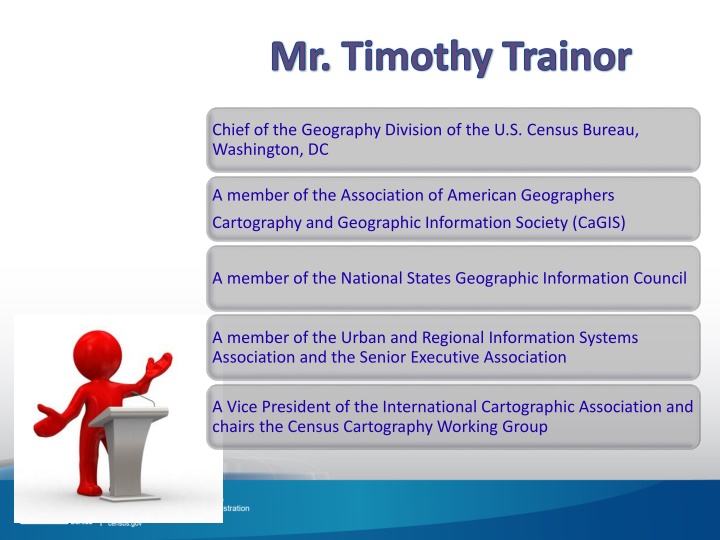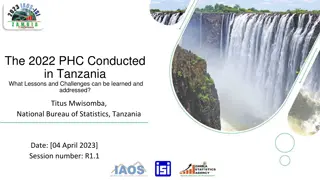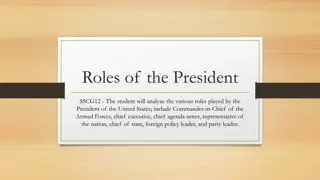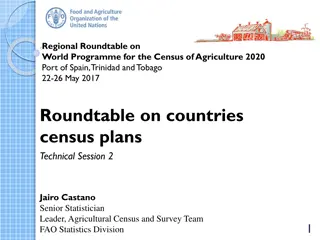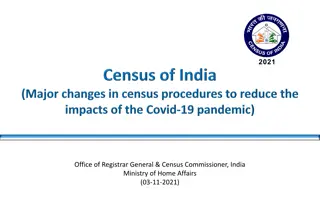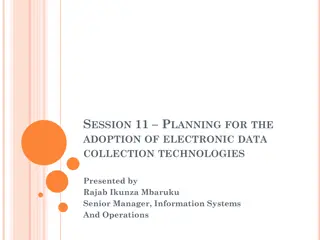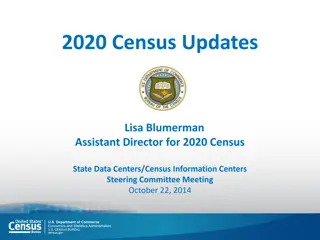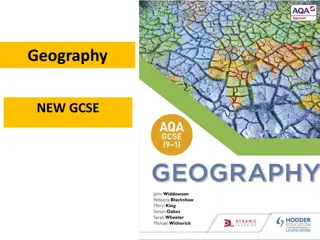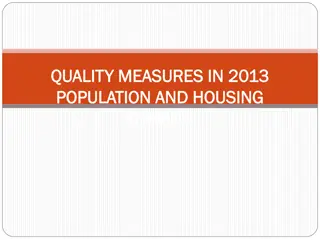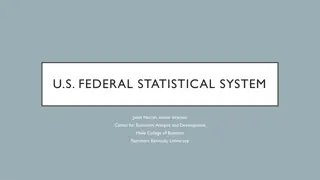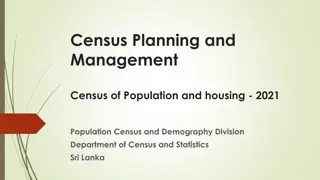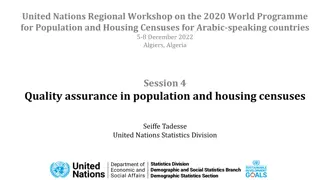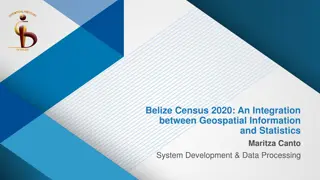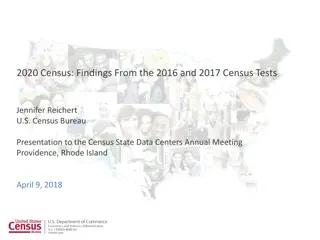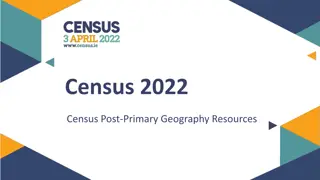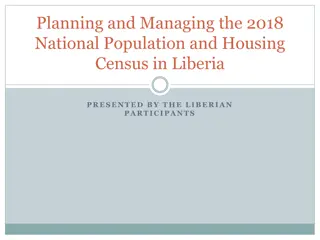Mr. Timothy Trainor, Chief of the Geography Division, U.S. Census Bureau
Chief of the Geography Division at the U.S. Census Bureau in Washington, DC, Mr. Timothy Trainor is a respected member of various geographical organizations, showcasing expertise in cartography and geographic information systems. With affiliations in esteemed associations such as the International Cartographic Association, he significantly contributes to the Census Cartography Working Group. His involvement in multiple councils and societies underscores his role in advancing geographical data and information systems on a national and international scale.
Download Presentation

Please find below an Image/Link to download the presentation.
The content on the website is provided AS IS for your information and personal use only. It may not be sold, licensed, or shared on other websites without obtaining consent from the author.If you encounter any issues during the download, it is possible that the publisher has removed the file from their server.
You are allowed to download the files provided on this website for personal or commercial use, subject to the condition that they are used lawfully. All files are the property of their respective owners.
The content on the website is provided AS IS for your information and personal use only. It may not be sold, licensed, or shared on other websites without obtaining consent from the author.
E N D
Presentation Transcript
Mr. Timothy Trainor Chief of the Geography Division of the U.S. Census Bureau, Washington, DC A member of the Association of American Geographers Cartography and Geographic Information Society (CaGIS) A member of the National States Geographic Information Council A member of the Urban and Regional Information Systems Association and the Senior Executive Association A Vice President of the International Cartographic Association and chairs the Census Cartography Working Group
The 2020 U.S. Census: A Time for Change Tim Trainor U.S. Census Bureau
Trends Adaptive design Mobile technologies and increased automation in the field Big data / paradata Focus on addresses for survey frames 3
Planning for the 2020 U.S. Census Contain costs Design and conduct a census that costs less per housing unit than the 2010 Census while maintaining high quality Identify cost drivers and implement innovative enumeration methods aimed at reducing these costs Plan based on research and testing Focus early research and testing program on major innovations to the design of the census oriented around major cost drivers of the 2010 Census 5
Census 2020 Objectives Contain costs Increased use of addresses A redesigned address canvassing operation Optimize self-response program Increase self-response options Make use of electronic contact strategies and methods Maximize internet response Increase awareness of the internet option Encourage respondents to respond via the internet Continue small area geographies for data users 6
Decennial Census Cost Drivers Need for nationwide updating of address list prior to Census Diversity of the population Demand for improved count accuracy Declining response rates Management of major acquisitions, schedule, and budget Field Infrastructure 7
Decennial Census Research Relative to Cost-Drivers Redesigned Address Canvassing Operation Administrative and Commercial Records Use of Mobile Technologies Streamlining and Automating Field Management and Operations Optimizing Self Response 8
Key Milestones Steps Towards 2020 Census 9
Adaptive Design A data collection is adaptive to the extent that it: Plans fieldwork to achieve cost and quality goals Monitors process data and cost and quality indicators Uses auxiliary frame data to tailor contact approaches (or impute or adjust) Uses auxiliary data, paradata and response data to change contact approaches rapidly Strikes data-based cost/quality tradeoffs 11
Adaptation is NOT New Sub-sampling non-respondents Increasing contacts Timing contacts Increasing incentives Tailoring survey invitations Tailoring refusal letters Switching modes 12
Some Adaptations ARE New More centralized, less ad hoc, more timely efforts, e.g. Using auxiliary data to tailor contacts Using auxiliary data, paradata and response data to alter contacts Switching modes based on auxiliary data, paradata and response data Motivated by a plan and enabled by new systems 13
Optimizing Self-Response Internet data collection Adaptive contact strategies New contact modes Telephone E-mail 14
Mobile Technologies and Increased Automation in the Field 15
Major Changes for Field Operations Using automation to support processes Optimized daily enumerator assignments of respondent contact attempts Near real time operations information for decision making Enhanced operational control system Automated training for enumerators and managers New field structure, including field staff roles and staffing ratios 16
Mobile Technologies Routing Navigation Data Collection 17
Field Reengineering and Nonresponse Followup (NRFU) using Administrative Records and Adaptive Design Reengineer the roles, responsibilities, and infrastructure for the field Evaluate the feasibility of fully utilizing the advantages of technology, automation, and real- time data to transform the efficiency and effectiveness of data collection operations Move to automated training for enumerators and managers Test and implement routing and/or navigation Reengineer the approach to case management 18
Field Reengineering and NRFU using Administrative Records and Adaptive Design (cont.) Reduce NRFU workload and increase NRFU productivity with: Administrative Records Reduce cases that need to be resolved in NRFU by varying type of cases removed and timing of case removal from the workload Reduce the number of contact attempts to cases resolved in NRFU Field Reengineering and Adaptive Design Reduce the number of contact attempts Leverage dynamic case management with route planning and other methodologies to improve enumerator productivity through automation Planned for an April 1 Census Day 19
Field Organizational Structure Admin Recruiting Technology Partnership Quality Control Regional Census Center (RCC) Supervise and Support AMOs Manage All Regional Operations Manage Space and Leasing Area Manager of Operations (AMO) Manage the Area Operations Support Center Supervise and Support FMOs Monitor Area Workload Progress Coordinate with RCC Field Manager of Operations (FMO) Supervise and Support LSOs Monitor FMO Zone Workload Progress Ensure Adequate Staffing Local Supervisor of Operations (LSO) Conduct In-Person Training Supervise and Support Enumerators Approve Time & Expense (T&E) Work Designated Shifts to Support On-Duty Enumerators Enumerators in the Field (ENUM) Receive Training Submit Available Schedule Conduct Field Work According to Schedule Complete Time and Expense (T&E) Maintain Ongoing Work Availability 20
Concept of Operations AMO Coordinates the Work of the Area Operations Support Center (AOSC) FMO Manages Field Operations Management Views In Operational Control Center AOSC LSO Supports Enumerators Manages Daily Workload Mobile Device Daily Workload Updates Enumerator Does the Work Training Certified Enumerator Load Production Application Mobile Device > Optimized Daily Workload and Routing Independent Study > > One day with LSO 21
Big Data 22
Big Data 23
Big Data Research Administrative records to improve cost and increase timeliness and accuracy Quality control Coverage improvement Substitute for in-person visits to households that do not self respond Processing techniques to allow real time decision making Adaptive design Self response options Data dissemination via API s to allow creation of apps and products that combine our data with other external data sets Census explorer data visualization Other apps from our web site More work required in this area to stimulate interest 24
Big Data: Concerns There are no currently acceptable processes or procedures for using Big Data to produce Official Statistics Don t even have a common definition of Big Data 25
Focus on Addresses for Survey Frames 26
The GSS Initiative (GSS-I) An integrated program of improved address coverage, continual spatial feature updates, and enhanced quality assessment and measurement All activities contribute to MAF/TIGER Database improvement Builds on the accomplishments of last decade s MAF/TIGER Enhancement Program (MTEP) Supports the goal of a redesigned address canvassing for the 2020 Census Continual updates throughout the decade support current surveys Address Updates Quality Measurement Stock Photo of Construction of house motor10 123 Testdata Road Anytown, CA 94939 Street/Feature Updates secn1_normaldistribution Lat 37 degrees, 9.6 minutes N Lon 119 degrees, 45.1 minutes W 27
Redesigned Address Canvassing General Questions: Is a traditional, on-the-ground canvassing operation necessary to ensure a complete and accurate address list for the decennial census? Are there areas of the country in which the address list and locational information can be kept current without canvassing? What characteristics identify an area that should be included in a traditional canvassing? 28
Research Goals Develop statistical models to identify geographic areas to be canvassed or not canvassed Predict adds and deletes with estimated coverage error Interactive Review - Identify and classify areas In which the number of addresses/housing units is stable and unlikely to change With unique housing/addressing/mail delivery situations that may require canvassing Land use/land cover is entirely non-residential Where the address list can be updated and assured through administrative or operational methods 29
Address Canvassing Research, Model, and Area Classification 2009 Statistical Model 2013 Statistical Model Interactive Review 27 test counties 30
MAF Error Model Objective The objective of the MEM project is to provide statistical models for the MAF that will produce estimates of coverage error at levels of geography down to the block level These models could potentially inform Address Canvassing decisions 31
What is the MAF Error Model? Two predictive models developed at the block level, collectively known as the MAF Error Model One model for the number of adds and one model for the number of deletes as functions of identified predictors Zero-inflated (ZI) regression models Zero-inflated models can provide a model-based approach to obtaining coverage estimates Provides more granularity at lower levels of geography over other common modeling approaches (e.g., logistic regression) 32
Address Canvassing: Master Address File (MAF) Model Validation Test and Focused Field Address Resolution Approach Model Based Approaches Test our ability to use statistical modeling to measure error in the MAF and to identify areas experiencing significant change Inform the performance of the models used to define the Address Canvassing workloads Focused Field Address Resolution ( micro-targeting ) Approach Incorporate imagery reviews to detect changes and discrepancies Include field updating of addresses for portions of blocks 33
MAF Model Validation Test Objectives The purpose of the MAF Model Validation Test (MMVT) is to collect data to inform components of the Address Canvassing decision-points MAF Error Model Address Canvassing, Research, Model, and Classification team Models for Zero Living Quarters blocks Test the concept of Micro-Targeting and uses of imagery 34
Getting to a Recommendation for a Redesigned Address Canvassing Operation Sept 2014 Methodology for inclusion determined First Round of Geographic Exclusions Identified Federal Lands Military Cost Estimation 2009 model Data Modeling Statistical 2009 2013 Empirical Partner File Acquisition Partner File Acquisition Data Upload Data Evaluation Quality Indicators 2020 Census Operations Defined Data Upload Data Evaluation Quality Indicators Assess results of the 2014 MAF Model Validation test Sept 2015 Models and Methodologies refined 35
Address Canvassing Methodology Plan Preliminary Federal Land Use and similar types of blocks - Preliminary Cost Estimation - Jan 2014 - March 2014 2009 TEA* Operational Overlay - Remove non-MO/MB areas (UL, UE ) 2009 Statistical Models (2020 and GSS) - Use only data available in 2009 Process definition occurs here and will be repeated Federal Land Use and 2009 TEA Operational Overlay - Cost Estimation - Quality Metrics (MMVT) - LCAT GEO go/no go Recommendation 9/14 Field Infra Decision Point 1/15 Preliminary Interactive Review 4/14 Use Aerial Imagery to add/remove blocks 2013 Statistical Models 4/14 Use only data available in 2013 LCAT will examine costs on later operations and provide feedback to modify models - Observe and measure the performance of the models - Update the models with more current field data (5 yr. field update) MAF Model Validation Test 9/14-12/14 Data available on January 2015 Consolidate the Models - Cost Estimation - Quality Metrics (QI and models) - LCAT - Recommendation for Integration 9/15 - Field Infrastructure Decision Point 1/16 2015 Methodology 3/15 Process Defined 36
Frame Schedule Jan 2014- Mar 2014 Sept 2014 Dec 2014 Nov 2013 Apr 2014 Jan 2015 July 2015 Sept 2015 Mar 2016 GEO go/no go Recommendation (Sept 2014) * Workloads * Production rates * Operational timeline Preliminary Federal Land Use and similar types of blocks Preliminary Interactive Review Use Aerial Imagery and Micro Targeting * 2009 Statistical Models (2020 and GSS) Use only data available in 2009 * Preliminary Field Infrastructure Decision Point * Estimate Preliminary AC Workload Consolidate the Models * Determine Preliminary Operational Design for AC *MAF Model Validation Test (MMVT) Data available in January/February 2015 2009 Type of Enumeration Area (TEA) Operational Overlay Remove non- MO/MB areas (UL, UE ) * Targeting Methodology Process Defined * 2013 Statistical Models Use only data available in 2013 * Final Field Infrastructure Decision Point (QI and models) LCAT * Cost Estimation Quality Metrics Analysis Preliminary Micro Targeting research Observe and measure the performance of the models Update the models with more current field data (5 yr. field update) * Preliminary Cost Estimation Quality Metrics (MMVT) Preliminary LCAT LCAT (Life Cycle Analysis Team) examine impacts on later operations * Denotes that the activity is in the current 2020 schedule Denotes GEO/GSS activity 37
Summary A redesigned census Traditional approaches are challenged Adds risk Modernization is critical All comes down to cost 38
Questions? 39
